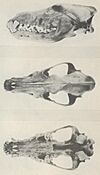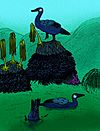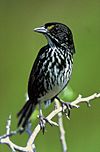List of North American animals extinct in the Holocene facts for kids
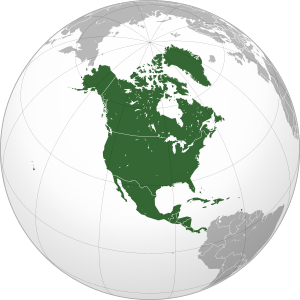
Map of North America
This list of North American animals extinct in the Holocene features animals known to have become extinct in the last 11,700 years on the North American continent. Animals recently extinct in the West Indies and Hawaii are in their own respective lists.
Many extinction dates are unknown due to a lack of relevant information.
Contents
- Mammals (class Mammalia)
- Armadillos, pampatheres, and glyptodonts (order Cingulata)
- Anteaters and sloths (order Pilosa)
- Elephant-like mammals (order Proboscidea)
- Sea cows (order Sirenia)
- Lagomorphs (order Lagomorpha)
- Rodents (order Rodentia)
- Carnivorans (order Carnivora)
- Odd-toed ungulates (order Perissodactyla)
- Even-toed ungulates (order Artiodactyla)
- Birds (class Aves)
- Landfowl (order Galliformes)
- Waterfowl (order Anseriformes)
- Grebes (order Podicipediformes)
- Swifts, treeswifts, and hummingbirds (order Apodiformes)
- Pigeons and doves (order Columbiformes)
- Rails and cranes (order Gruiformes)
- Shorebirds (order Charadriiformes)
- Albatrosses and petrels (order Procellariiformes)
- Storks and allies (order Ciconiiformes)
- New World vultures (order Cathartiformes)
- Hawks and relatives (order Accipitriformes)
- Owls (order Strigiformes)
- Falcons (order Falconiformes)
- Woodpeckers and allies (order Piciformes)
- Parrots (order Psittaciformes)
- Perching birds (order Passeriformes)
- Reptiles (class Reptilia)
- Amphibians (class Amphibia)
- Ray-finned fish (class Actinopterygii)
- Malacostracans (class Malacostraca)
- Insects (class Insecta)
- Arachnids (class Arachnida)
- Molluscs
- See also
Mammals (class Mammalia)
Armadillos, pampatheres, and glyptodonts (order Cingulata)
Chlamyphorid armadillos and glyptodonts (family Chlamyphoridae)
| Common name | Scientific name | Range | Comments | Pictures |
|---|---|---|---|---|
| North American glyptodont | Glyptotherium sp. | Gulf of Mexico coast to northeastern Brazil | Most recent remains at Quetzaltenango, Guatemala dated to 9948-9306 BCE. |  |
Anteaters and sloths (order Pilosa)
Megalonychid ground sloths (family Megalonychidae)
| Common name | Scientific name | Range | Comments | Pictures |
|---|---|---|---|---|
| Jefferson's ground sloth | Megalonyx jeffersoni | Alaska to northern Mexico | Most recent remains dated to 9540-9420 BCE. |  |
| Xibalbaonyx oviceps | Puerto Morelos, Mexico | Most recent remains at El Zapote cenote dated to 8697-8355 BCE. |
Mylodonts (family Mylodontidae)
| Common name | Scientific name | Range | Comments | Pictures |
|---|---|---|---|---|
| Harlan's ground sloth | Paramylodon harlani | Mexico, Southern and Western United States | Most recent remains dated to 9880-8280 BCE. |  |
Nothrotheriid ground sloths (family Nothrotheriidae)
| Common name | Scientific name | Range | Comments | Pictures |
|---|---|---|---|---|
| Shasta ground sloth | Nothrotheriops shastensis | California to Yucatan | Most recent remains dated to 8725-8175 BCE. |  |
Elephant-like mammals (order Proboscidea)
Gomphotheres (family Gomphotheriidae)
| Common name | Scientific name | Range | Comments | Pictures |
|---|---|---|---|---|
| Cuvier's gomphothere | Cuvieronius hyodon | Central America, northern and central Andes | Most recent remains at Estanzuela, Guatemala dated to 9117-8793 BCE. |  |
Mastodons (family Mammutidae)
| Common name | Scientific name | Range | Comments | Pictures |
|---|---|---|---|---|
| American mastodon | Mammut americanum | North America | Most recent remains dated to 7110-6810 BCE. |  |
Elephants and mammoths (family Elephantidae)
| Common name | Scientific name | Range | Comments | Pictures |
|---|---|---|---|---|
| Columbian mammoth | Mammuthus columbi | Southern and Western United States, and northern Mexico | Most recent remains dated to 8080-7700 BCE. |  |
| Pygmy mammoth | Mammuthus exilis | Santa Rosae island, California | Most recent remains dated to 9130-9030 BCE. |  |
| Woolly mammoth | Mammuthus primigenius | Northern Eurasia and North America | Most recent remains at St. Paul, Alaska dated to 3635-3580 BCE. |  |
Sea cows (order Sirenia)
Dugongs (family Dugongidae)
| Common name | Scientific name | Range | Comments | Pictures |
|---|---|---|---|---|
| Steller's sea cow | Hydrodamalis gigas | Bering Sea | Most recent remains at Kiska, Alaska dated to 1710-1785 CE. |  |
Lagomorphs (order Lagomorpha)
Pikas (family Ochotonidae)
| Common name | Scientific name | Range | Comments |
|---|---|---|---|
| Giant pika | Ochotona whartoni | Northern North America and possibly northeastern Siberia | Most recent remains dated to 8301-7190 BCE. |
Rodents (order Rodentia)
Beavers (family Castoridae)
| Common name | Scientific name | Range | Comments | Pictures |
|---|---|---|---|---|
| Giant beaver | Castoroides ohioensis | North America | Most recent remains at Wayne County, New York dated to 8250-8150 BCE. |  |
Hamsters, voles, lemmings, muskrats, and New World rats and mice (family Cricetidae)
| Common name | Scientific name | Range | Comments | Pictures |
|---|---|---|---|---|
| Gull Island vole | Microtus pennsylvanicus nesophilus | Great Gull Island, New York | Disappeared around 1900, when the Harbor Defenses of Long Island Sound were built. | |
| Anthony's woodrat | Neotoma bryanti anthonyi | Isla Todos Santos, Mexico | Last recorded in 1926. Extinct due to predation by introduced feral cats. | |
| Bunker's woodrat | Neotoma bryanti bunkeri | Coronados Islands, Mexico | Last recorded in 1931. Likely extinct due to depletion of food sources and predation by introduced cats. | |
| San Martín Island woodrat | Neotoma bryanti martinensis | Isla San Martín, Mexico | Last recorded in the 1950s. Extinct due to predation by introduced cats. | |
| Nelson's rice rat | Oryzomys nelsoni | María Madre Island, Mexico | Last recorded in 1897. Possibly extinct due to introduced black rats. |  |
| Giant island deer mouse | Peromyscus nesodytes | Channel Islands of California | Most recent remains at Cave of the Chimneys, San Miguel Island, dated to around 950 CE. If the species survived into historical times it might have become extinct due to overgrazing, increased wind and water erosion destroying its natural habitat. | |
| Pallid beach mouse | Peromyscus polionotus decoloratus | Coastal Florida | Last recorded in 1946. Extinct due to extensive habitat loss. |
Possibly extinct
| Common name | Scientific name | Range | Comments |
|---|---|---|---|
| Puebla deer mouse | Peromyscus mekisturus | Southeast Puebla, Mexico | Last recorded in 1957. Possibly extinct due to habitat degradation caused by agriculture or climate change. |
Gophers (family Geomyidae)
| Common name | Scientific name | Range | Comments |
|---|---|---|---|
| Goff's pocket gopher | Geomys pinetis goffi | Pineda Ridge, Florida | Last recorded in 1955. |
| Tacoma pocket gopher | Thomomys mazama tacomensis | Tacoma-Steilacoom, Washington area | Last collected in 1962. Extinct due to habitat alteration through residential development and gravel mining. |
Carnivorans (order Carnivora)
Cats (family Felidae)
| Common name | Scientific name | Range | Comments | Pictures |
|---|---|---|---|---|
| North American sabertooth cat | Smilodon fatalis | Southern Alberta to northwestern South America | Most recent remains dated to 7615-7305 BCE. |  |
Locally extinct
| Common name | Scientific name | Range | Comments | Pictures |
|---|---|---|---|---|
| Eastern cougar | Population of the North American cougar (Puma concolor couguar) | Eastern North America | Last confirmed individual trapped in Somerset County, Maine in 1938. Though named as a distinct subspecies in 1946, genetic research indicates that no population of North American cougars is different enough to warrant subspecies status, and the taxon P. c. couguar is not extinct as a result. |  |
Dogs (family Canidae)
| Common name | Scientific name | Range | Comments | Pictures |
|---|---|---|---|---|
| Kenai Peninsula wolf | Canis lupus alces | Kenai Peninsula, Alaska | Exterminated through hunting, trapping, and poisoning by 1915. Wolves recolonized the Peninsula in 1962, a decade after predator eradication efforts were reduced. | |
| Newfoundland wolf | Canis lupus beothucus | Newfoundland | Last known individual killed in 1896. |  |
| Banks Island wolf | Canis lupus bernardi | Banks Island, Northwest Territories | Last recorded between 1918 and 1952. Considered a synonym of the arctic wolf (C. l. arctos) by some authors on morphological grounds. |  |
| Cascade Mountains wolf | Canis lupus fuscus | Pacific Northwest | Last recorded in 1940. Considered a synonym of the Great Plains wolf (C. l. nubilus) by some authors. |  |
| Mogollon mountain wolf | Canis lupus mogollonensis | Arizona | Last recorded in 1935. Considered a synonym of the Great Plains wolf (C. l. nubilus) or the Mexican wolf (C. l. baileyi) by different authors. |  |
| Texas gray wolf | Canis lupus monstrabilis | Texas | Last recorded in 1942. Considered a synonym of the Mexican wolf (C. l. baileyi) by some authors. |  |
| Southern Rocky Mountain wolf | Canis lupus youngi | Southern Rocky Mountains | Last recorded in 1935. |  |
| Florida black wolf | Canis rufus floridanus | Eastern United States | Extinct by 1920 as a result of deliberate eradication efforts, habitat destruction, and loss of prey. |  |
| Gregory's wolf | Canis rufus gregoryi | Lower Mississippi Valley |  |
|
| Southern California kit fox | Vulpes macrotis macrotis | Southern California coast | Last collected in 1903. |
Extinct in the wild
| Common name | Scientific name | Range | Comments | Pictures |
|---|---|---|---|---|
| Mexican wolf | Canis lupus baileyi | Southwestern United States and northern Mexico | Extirpated from the wild in the early 1970s and reintroduced in 1998. |  |
| Texas red wolf | Canis rufus rufus | Central Texas to southern Louisiana | Extinct in the wild by 1980 and introduced (in lieu of the extinct subspecies) to eastern North Carolina in 1987. The species is threatened by human persecution and hybridization with coyotes. Declined as a result of deliberate eradication efforts, habitat destruction, and hybridization with the coyote. |  |
Bears (family Ursidae)
| Common name | Scientific name | Range | Comments | Pictures |
|---|---|---|---|---|
| Giant short-faced bear | Arctodus simus | North America | Most recent remains dated to 8995-8845 BCE. |  |
Locally extinct
| Common name | Scientific name | Range | Comments | Pictures |
|---|---|---|---|---|
| California grizzly bear | Population of the grizzly bear (Ursus arctos horribilis) | California | Last recorded at Sequoia National Park in 1924. Though once named as the subspecies U. a. californicus, DNA evidence shows that it is not different enough to warrant separate status. |  |
| Mexican grizzly bear | Population of the grizzly bear (Ursus arctos horribilis) | Aridoamerica | Last known individual killed in northern Sonora in 1976. Though once named as the subspecies U. a. nelsoni, DNA evidence shows that it is not different enough to warrant separate status. |  |
| Ungava brown bear | Population of the grizzly bear (Ursus arctos horribilis) | Ungava Peninsula, Quebec | Known from subfossil remains, indigenous folklore and sporadic hunting records of the 18th and 19th centuries. Possible last sighting in 1942, but it could also have been a brown morph of the American black bear. | 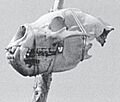 |
Earless seals (family Phocidae)
| Common name | Scientific name | Range | Comments | Pictures |
|---|---|---|---|---|
| Caribbean monk seal | Neomonachus tropicalis | Caribbean Sea, Bahamas, and the Gulf of Mexico | Last recorded in southern Florida in 1922 and Yucatan in 1950. It was intensely hunted for its skin and oil, and persecuted as a competitor by fishermen in later times. |  |
Martens, polecats, otters, badgers, and weasels (family Mustelidae)
| Common name | Scientific name | Range | Comments | Pictures |
|---|---|---|---|---|
| Sea mink | Neogale macrodon | Atlantic coast of Canada and New England | Hunted to extinction by fur traders by about 1860. Later records up to 1894 are actually references to the American mink. |  |
Extinct in the wild
| Common name | Scientific name | Range | Comments | Pictures |
|---|---|---|---|---|
| Black-footed ferret | Mustela nigripes | Great Plains | Extinct in the wild in 1987 and reintroduced in 1991. Declined due to persecution as agricultural pest of its main prey, the prairie dog; introduced diseases like canine distemper and plague, and conversion of grasslands to agriculture. |  |
Odd-toed ungulates (order Perissodactyla)
Horses and allies (family Equidae)
Locally extinct
| Common name | Scientific name | Range | Comments | Pictures |
|---|---|---|---|---|
| Wild horse | Equus ferus | Eurasia and the Americas | Environmental DNA last detected in permafrost of central Yukon dated to 3979-2640 BCE. The Yukon population has been identified at times as a different species of caballine horse (Equus lambei) and a wild ass (both Equus hemionus and Equus africanus) on morphological grounds, but ancient mtDNA studies confirms caballine affiliation. Domestic horses were introduced to the Americas by the Spanish in 1493 and a feral population was established in Querétaro, Mexico by 1553. |  |
Even-toed ungulates (order Artiodactyla)
Camels and llamas (family Camelidae)
| Common name | Scientific name | Range | Comments | Pictures |
|---|---|---|---|---|
| Western camel | Camelops hesternus | Western North America | Most recent remains dated to 8170-7840 BCE. |  |
Peccaries (family Tayassuidae)
| Common name | Scientific name | Range | Comments | Pictures |
|---|---|---|---|---|
| Flat-headed peccary | Platygonus compressus | Southern and eastern United States, and northern Mexico | Most recent remains dated to 8990-8690 BCE. |  |
Gray whales (family Eschrichtiidae)
Locally extinct
| Common name | Scientific name | Range | Comments | Pictures |
|---|---|---|---|---|
| Atlantic gray whale | Population of the gray whale (Eschrichtius robustus) | North Atlantic Ocean and Mediterranean Sea | Last recorded in 1760. The same species survives on the Pacific Ocean. A single individual, presumably dispersed over the Arctic, was observed off Florida in 2023 and Nantucket, Massachusetts in 2024. |
True deer (family Cervidae)
Locally extinct
| Common name | Scientific name | Range | Comments | Pictures |
|---|---|---|---|---|
| Stag-moose | Cervalces scotti | Great Lakes Region | Most recent remains dated to 9230-8930 BCE. |  |
| Eastern elk | Population of the North American wapiti (Cervus canadensis canadensis) | Eastern North America | Traditionally considered the nominate subspecies, but genetic research indicates that there are not enough differences to consider separate subspecies of C. canadensis in North America, and the taxon C. c. canadensis is not extinct as a result. The last confirmed individual was killed near the Clarion River of central Pennsylvania in 1867, though there were unconfirmed sightings in 1869-1870, and ten claimed killings in northern Pennsylvania in 1878. Western elk were reintroduced for hunting purposes in the same state in 1912. |  |
| Merriam's elk | Population of the North American wapiti (Cervus canadensis canadensis) | New Mexico, Arizona, and West Texas | Named as the species Cervus merriami in 1902 on the basis of a single skull; in 1978, an anatomical review of a dozen individuals found just enough of a case to consider it a subspecies of Cervus elaphus (later C. canadensis). Further anatomical and genetic research suggest that all American wapiti likely belong to the same subspecies and that the taxon C. c. merriami is a synonym of C. c. canadensis. Wapiti from other regions have been reintroduced to the purported distribution area of Merriam's elk. | |
| Queen Charlotte Islands caribou | Population of the caribou (Rangifer tarandus) | Graham Island, British Columbia | Described as the subspecies R. t. dawsoni in 1900 due to its isolated location and anatomical differences, but mtDNA studies in 2002 showed not enough differences to warrant separate status. The last known herd was found in 1908, comprising two adult males, one female, and one calf; all but the calf were killed. |
Cattle, goats, antelopes, and others (family Bovidae)
| Common name | Scientific name | Range | Comments | Pictures |
|---|---|---|---|---|
| Ancient bison | Bison antiquus | North America | A transitional form between steppe bison and modern American bison whose more recent remains date to the early Holocene of Valsequillo basin in Puebla, Mexico. However the direct dating to 5271-5131 BCE is not calibrated and the remains could be older. Other remains in North America have been dated to 8640-8500 BCE. |  |
| Western bison | Bison occidentalis | Eastern Beringia | Another transitional form to American bison that originated in a second dispersal of steppe bison across Beringia, and persisted in Alaska until around 220 CE. |  |
| Steppe bison | Bison priscus | Northern Eurasia and North America | Most recent remains at Whitehorse, Yukon dated to 3628-3377 BCE. | 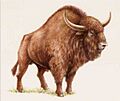 |
| Woodland muskox | Bootherium bombifrons | North America | Most recent remains dated to 9110-8950 BCE. |  |
| Shrub-ox | Euceratherium collinum | Western United States and Mexico | Most recent remains dated to 9830-9530 BCE. | 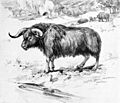 |
| Harrington's mountain goat | Oreamnos harringtoni | Southern Rocky Mountains | Most recent remains at Rampart Cave, Arizona dated to 11099-8478 BCE. |  |
Locally extinct
| Common name | Scientific name | Range | Comments | Pictures |
|---|---|---|---|---|
| Wild yak | Bos mutus | Tibet to eastern Siberia and Beringia | Environmental DNA last detected in permafrost of central Yukon dated to 8231-7959 BCE. |  |
Birds (class Aves)
Landfowl (order Galliformes)
Pheasants and allies (family Phasianidae)
| Common name | Scientific name | Range | Comments | Pictures |
|---|---|---|---|---|
| Californian turkey | Meleagris californica | California | Most recent remains dated to 9100-8380 BCE. However this date was not calibrated and the remains could be older. |  |
| Southwestern turkey | Meleagris crassipes | New Mexico | Most recent remains dated to 11510-8770 BCE (uncalibrated date). | |
| Heath hen | Tympanuchus cupido cupido | East coast of the United States | Last individual, a male, died in Martha's Vineyard in 1932. |  |
| New Mexico sharp-tailed grouse | Tympanuchus phasianellus hueyi | New Mexico and possibly Colorado | Last individual killed in Colfax County, New Mexico in 1952. |
Waterfowl (order Anseriformes)
Ducks, geese, and swans (family Anatidae)
| Common name | Scientific name | Range | Comments | Pictures |
|---|---|---|---|---|
| Schneider's teal | Anas schneideri | Little Box Elder Cave, Wyoming | Most recent remains dated to 8800-8300 BCE (uncalibrated date). | |
| Labrador duck | Camptorhynchus labradorius | Atlantic coast of Canada and New England | Last confirmed individual killed in 1875; unconfirmed in 1878. |  |
| Law's diving-goose | Chendytes lawi | Coastal California and Oregon | Most recent remains at Ventura County, California dated to 770-400 BCE. |
Grebes (order Podicipediformes)
Grebes (family Podicipedidae)
| Common name | Scientific name | Range | Comments | Pictures |
|---|---|---|---|---|
| Atitlán grebe | Podilymbus gigas | Lake Atitlán, Guatemala | Extinct in 1983-1986 due to competition and predation by introduced largemouth bass, reed-cutting for tourism development, falling water levels after the 1976 Guatemala earthquake, drowning in gill nets and disturbance by boat traffic. | 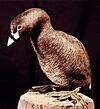 |
Swifts, treeswifts, and hummingbirds (order Apodiformes)
Hummingbirds (family Trochillidae)
Possibly extinct
| Common name | Scientific name | Range | Comments |
|---|---|---|---|
| Guanacaste hummingbird | Amazilia alfaroana | Miravalles Volcano, Costa Rica | Only known from the holotype collected in 1895. The cause of extinction is unknown, but could be related to habitat loss caused by agriculture. |
Pigeons and doves (order Columbiformes)
Pigeons and doves (family Columbidae)
| Common name | Scientific name | Range | Comments | Pictures |
|---|---|---|---|---|
| Passenger pigeon | Ectopistes migratorius | Eastern North America | One of the most numerous birds at the beginning of the 19th century, it declined dramatically as a result of hunting, Newcastle disease, and the clearance of hardwood trees in which it fed, until the last individual in the wild was shot in 1900. The last captive individual, Martha, died at Cincinnati Zoo in 1914. |  |
Extinct in the wild
| Common name | Scientific name | Range | Comments | Pictures |
|---|---|---|---|---|
| Socorro dove | Zenaida graysoni | Socorro Island, Mexico | Last recorded in the wild in 1972. It declined as a result of predation by introduced cats, hunting, and habitat degradation caused by feral goats and Central American locusts. Individuals survive in captivity in the United States, though several are hybridized with the mourning dove (Z. macroura). |  |
Rails and cranes (order Gruiformes)
Rails (family Rallidae)
Possibly extinct
| Common name | Scientific name | Range | Comments |
|---|---|---|---|
| Goldman's yellow rail | Coturnicops noveboracensis goldmani | Lerma River, Mexico | Last recorded in 1964. |
Cranes (family Gruidae)
| Common name | Scientific name | Range | Comments |
|---|---|---|---|
| Page's crane | Grus pagei | Rancho La Brea, California | Most recent remains dated to 10250-9180 BCE (uncalibrated date). |
Shorebirds (order Charadriiformes)
Plovers, dotterels, and lapwings (family Charadriidae)
| Scientific name | Range | Comments |
|---|---|---|
| Vanellus downsi | Rancho La Brea, California | Most recent remains dated to 38050-8050 BCE (uncalibrated date). |
Sandpipers (family Scolopacidae)
Possibly extinct
| Common name | Scientific name | Range | Comments | Pictures |
|---|---|---|---|---|
| Eskimo curlew | Numenius borealis | Americas | Last confirmed record in Nebraska in 1987; an unconfirmed sighting happened in Manitoba in 1996. Declined due to hunting, conversion of prairies for agriculture, and the suppression of the fire regime. The breeding grounds in the Arctic have since been taken over by the larger Hudsonian whimbrel. Another factor may have been the extinction of the Rocky Mountain locust. |  |
Auks (family Alcidae)
| Common name | Scientific name | Range | Comments | Pictures |
|---|---|---|---|---|
| Great auk | Pinguinus impennis | Northern Atlantic and western Mediterranean | Last recorded off the Newfoundland Banks in 1852. It was hunted to extinction. |  |
Albatrosses and petrels (order Procellariiformes)
Northern storm petrels (family Hydrobatidae)
Possibly extinct
| Common name | Scientific name | Range | Comments | Pictures |
|---|---|---|---|---|
| Guadalupe storm-petrel | Hydrobates macrodactylus | Guadalupe Island, Mexico | Last recorded in 1912. Likely extinct due to breeding habitat degradation by introduced feral goats and predation by feral cats and dogs; however the natural difficulty of its detection, lack of thorough surveys in the breeding season after 1906 and reports of unidentified storm-petrel calls at night may indicate that it is still extant. |  |
Storks and allies (order Ciconiiformes)
Storks (family Ciconiidae)
| Common name | Scientific name | Range | Comments | Pictures |
|---|---|---|---|---|
| La Brea stork | Ciconia maltha | Americas | Most recent remains dated to 9050-8050 BCE (uncalibrated date). |
New World vultures (order Cathartiformes)
New World vultures and condors (family Cathartidae)
| Common name | Scientific name | Range | Comments | Pictures |
|---|---|---|---|---|
| Painted vulture | Sarcoramphus sacra | Florida | Hypothetical species known from a 1774 description by William Bartram. Though traditionally dismissed as a hoax or incorrect description of a king vulture from Central and South America (S. papa), which it resembled in everything except the tail's coloration and more predatory behavior, a 1734 account of the same bird and painting by Eleazar Albin, and a 1786 depiction of the tail feathers as part of a standard used by the Muscogee king Mico Chlucco suggest that it was an actual extirpated Floridan population of the king vulture, subspecies, or related species. | 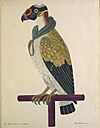 |
Extinct in the wild
| Common name | Scientific name | Range | Comments | Pictures |
|---|---|---|---|---|
| California condor | Gymnogyps californianus | North America | Extinct in the wild in 1987 and reintroduced in 1992. |  |
Teratorns (family Teratornithidae)
| Common name | Scientific name | Range | Comments | Pictures |
|---|---|---|---|---|
| Slender teratorn | Cathartornis gracilis | Southern California | Most recent remains dated to 38050-8050 BCE (uncalibrated date). |  |
| Merriam's teratorn | Teratornis merriami | Southern California to northern Arizona | Most recent remains dated to 9050-8050 BCE (uncalibrated date). |  |
Hawks and relatives (order Accipitriformes)
Hawks, eagles, kites, harriers and Old World vultures (family Accipitridae)
| Common name | Scientific name | Range | Comments | Pictures |
|---|---|---|---|---|
| Daggett's eagle | Buteogallus daggetti | Southwestern United States and Nuevo León, Mexico | Most recent remains dated to 10250-9180 BCE (uncalibrated date). | |
| Woodward's eagle | Buteogallus woodwardi | California to Florida and the Caribbean | Most recent remains dated to 38050-8050 BCE (uncalibrated date). | 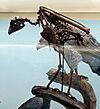 |
| Neophrontops americanus | Rancho La Brea, California | Most recent remains dated to 10230-7630 BCE (uncalibrated date). | ||
| Grinnell's hawk-eagle | Spizaetus grinnelli | Rancho La Brea, California | Most recent remains dated to 10250-9180 BCE (uncalibrated date). |
Owls (order Strigiformes)
True owls (family Strigidae)
| Common name | Scientific name | Range | Comments | Pictures |
|---|---|---|---|---|
| Socorro elf owl | Micrathene whitneyi graysoni | Socorro Island, Mexico | Last recorded around 1970. Likely extinct due to predation by introduced cats. | |
| La Brea owl | Oraristrix brea | Southern California | Most recent remains dated to 10250-9180 BCE (uncalibrated date). | 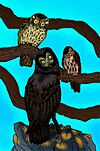 |
Falcons (order Falconiformes)
Falcons and caracaras (family Falconidae)
| Common name | Scientific name | Range | Comments | Pictures |
|---|---|---|---|---|
| Guadalupe caracara | Caracara lutosa | Guadalupe Island, Mexico | Deliberately exterminated by settlers in 1903. |  |
Woodpeckers and allies (order Piciformes)
Woodpeckers (family Picidae)
| Common name | Scientific name | Range | Comments |
|---|---|---|---|
| Guadalupe flicker | Colaptes auratus rufipileus | Guadalupe Island, Mexico | Last collected in 1906. Extinct due to habitat destruction by introduced goats and predation by cats. |
Possibly extinct
| Common name | Scientific name | Range | Comments | Pictures |
|---|---|---|---|---|
| Imperial woodpecker | Campephilus imperialis | North-central Mexico | Last confirmed record in Durango in 1956, but unconfirmed sightings continued until 2005 in the Copper Canyon of Chihuahua. Declined due to habitat destruction and poisoning by loggers, along with hunting for sport, food, and traditional medicine. | 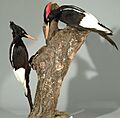 |
| American ivory-billed woodpecker | Campephilus principalis principalis | Southern United States | Last confirmed record in north-eastern Louisiana in 1944. Several unconfirmed sightings, video and sound records were made in eastern Arkansas in 2004, the Choctawhatchee River in Florida in 2005-2007, and 2006-2007 in Louisiana. Declined due to hunting, logging and forest clearance for agriculture. |  |
Parrots (order Psittaciformes)
Holotropical parrots (family Psittacidae)
| Common name | Scientific name | Range | Comments | Pictures |
|---|---|---|---|---|
| Carolina parakeet | Conuropsis carolinensis | Eastern and Central United States | Last collected in the wild near Lake Okeechobee, Florida in 1904 though unconfirmed reports continued until the 1930s. The last captive individual died in Cincinnati Zoo in 1918. Declined due to hunting, persecution by crop farmers, deforestation, and competition with introduced bees. |  |
Perching birds (order Passeriformes)
True finches (family Fringillidae)
| Common name | Scientific name | Range | Comments |
|---|---|---|---|
| McGregor's house finch | Carpodacus mexicanus mcgregori | San Benito and Cedros Islands, Mexico | Last recorded in 1938. |
New World blackbirds (family Icteridae)
| Common name | Scientific name | Range | Comments | Pictures |
|---|---|---|---|---|
| Large-billed black bird | Euphagus magnirostris | California to Venezuela and Peru | Most recent remains dated to 8800-8300 BCE (uncalibrated date). | |
| Convex-billed cowbird | Pandanaris convexa | California and Florida to Peru | Most recent remains dated to 38050-8050 BCE (uncalibrated date). | |
| Pyelorhamphus molothroides | Shelter Cave, New Mexico | Most recent remains dated to 29300-9380 BCE (uncalibrated date). | ||
| Slender-billed grackle | Quiscalus palustris | Lerma River and Xochimilco, Mexico | Last collected in 1910. Extinct due to the draining of its marsh habitat. |  |
New World sparrows (family Passerellidae)
| Common name | Scientific name | Range | Comments | Pictures |
|---|---|---|---|---|
| Dusky seaside sparrow | Ammospiza maritima nigrescens | Merritt Island and Titusville, Florida | Declined due to DDT use in marshes and habitat loss caused by dam construction. In 1981 the last five individuals, all male, were captured and taken into captivity. However, a proposed plan to hybridize them with Scott's seaside sparrow and select the offspring with most dusky ancestry wasn't allowed because of legal restrictions against hybridizing endangered taxa. The last individual died in Walt Disney World's Discovery Island Zoological Park in Orlando, Florida in 1987. | |
| Pipilo angelensis | Rancho La Brea, California | Most recent remains dated to 38050-8050 BCE (uncalibrated date). | ||
| Guadalupe towhee | Pipilo maculatus consobrinus | Guadalupe Island, Mexico | Last recorded in 1897. Extinct due to destruction of nesting habitat by introduced goats, and predation by cats. | |
| Zacatecas Worthen's sparrow | Spizella wortheni browni | Northwest Zacatecas, Mexico | Last recorded in 1961. Extinct due to habitat loss to agriculture, overgrazing and erosion by cattle herding, and decline of native herbivores which maintained the bird's habitat. |
Wrens (family Troglodytidae)
| Common name | Scientific name | Range | Comments |
|---|---|---|---|
| San Benedicto rock wren | Salpinctes obsoletus exsul | San Benedicto Island, Mexico | Wiped out by the eruption of El Boquerón volcano in 1952. |
| Guadalupe wren | Thryomanes bewickii brevicauda | Guadalupe Island, Mexico | Last recorded in 1897. Extinct due to habitat destruction by introduced goats. |
| San Clemente wren | Thryomanes bewickii leucophrys | San Clemente Island, California | Last recorded in 1968. Extinct due to habitat destruction by introduced goats and sheep. |
New World warblers (family Parulidae)
Possibly extinct
| Common name | Scientific name | Range | Comments | Pictures |
|---|---|---|---|---|
| Bachman's warbler | Vermivora bachmanii | Southeastern United States and Cuba | Last recorded in Louisiana in 1988. Declined due to habitat loss caused by deforestation and marshland draining, followed by intensive hunting by bird collectionists as it became rare. |  |
Reptiles (class Reptilia)
Turtles and tortoises (order Testudines)
Mud and musk turtles (family Kinosternidae)
| Common name | Scientific name | Range | Comments |
|---|---|---|---|
| Viesca mud turtle | Kinosternon hirtipes megacephalum | Viesca Lake, southwestern Coahuila, Mexico | Only known from the type series collected in 1961. The lake has since been drained by humans. |
Tortoises (family Testudinidae)
| Common name | Scientific name | Range | Comments |
|---|---|---|---|
| Southeastern giant tortoise | Hesperotestudo crassiscutata | Southern United States | Most recent remains dated to around 9515 BCE. |
| Wilson's tortoise | Hesperotestudo wilsoni | Southwestern United States | Most recent remains dated to around 9050 BCE. |
Amphibians (class Amphibia)
Frogs (order Anura)
True toads (family Bufonidae)
| Common name | Scientific name | Range | Comments | Pictures |
|---|---|---|---|---|
| Chiriqui harlequin frog | Atelopus chiriquiensis | Talamanca-Chiriqui Mountains, Costa Rica | Last recorded in 1996. Extinct due to chytridiomycosis caused by the fungus Batrachochytrium dendrobatidis. |  |
| Pass stubfoot toad | Atelopus senex | Central Costa Rica | Last recorded in 1986. Extinct due to chytridiomycosis. | |
| Golden toad | Incilius periglenes | Monteverde Cloud Forest Reserve, Costa Rica | Last recorded in 1989. Probably extinct due to climate change, chytridiomycosis, and airborne pollution. |  |
Extinct in the wild
| Common name | Scientific name | Range | Comments | Pictures |
|---|---|---|---|---|
| Wyoming toad | Anaxyrus baxteri | Laramie Basin, Wyoming | Survives only at the four-times impounded Mortenson Lake National Wildlife Refuge, where it last reproduced naturally in 1991 and is re-stocked annually with captive born toadlets. The species is affected by chytridiomycosis, bacteria, pesticides, irrigation practices, lack of genetic diversity, predation by mustelids, drought, increased salinity, and expansion of the salt cedar which reduces habitat suitability. |  |
| Panamanian golden frog | Atelopus zeteki | El Valle de Antón and Cerro Campana, Panama | Last recorded in the wild in 2009. The species is mainly threatened by chytridiomycosis, but also deforestation, water pollution, collection for the pet trade, and increased sedimentation of streams caused by road construction. |  |
Freshbelly frogs (family Craugastoridae)
| Scientific name | Range | Comments |
|---|---|---|
| Craugastor myllomyllon | Finca Volcán, Alta Verapaz, Guatemala | Last recorded in 1978. Its natural habitat was destroyed by agriculture. |
Possibly extinct
| Common name | Scientific name | Range | Comments |
|---|---|---|---|
| McCranie's robber frog | Craugastor chrysozetetes | La Ceiba, Atlántida Department, Honduras | Last recorded in 1989. Possibly extinct due to catastrophic landslides caused by Hurricane Mitch, or chytridiomycosis. |
Poison dart frogs (family Dendrobatidae)
| Common name | Scientific name | Range | Comments | Pictures |
|---|---|---|---|---|
| Splendid poison frog | Oophaga speciosa | Western Panama | Last recorded in 1992. Extinct due to chytridiomycosis. | 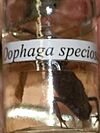 |
Tree frogs and allies (family Hylidae)
Possibly extinct
| Common name | Scientific name | Range | Comments | Pictures |
|---|---|---|---|---|
| Rabbs' fringe-limbed treefrog | Ecnomiohyla rabborum | El Valle de Antón, Panama | Last recorded in the wild in 2008, two years after chytridiomycosis invaded its natural habitat. The last captive animal, a male named Toughie, died at the Atlanta Botanical Garden in 2016. |  |
Salamanders (order Urodela)
Lungless salamanders (family Plethodontidae)
| Common name | Scientific name | Range | Comments |
|---|---|---|---|
| Ainsworth's salamander | Plethodon ainsworthi | Jasper County, Mississippi | Last recorded in 1964. Possibly extinct due to deforestation. |
| Jalpa false brook salamander | Pseudoeurycea exspectata | Cerro Miramundo, Jalapa, Guatemala | Last recorded in 1976. Possibly extinct due to habitat loss to farming and logging. |
Ray-finned fish (class Actinopterygii)
Minnows and allies (order Cypriniformes)
Suckers (family Catostomidae)
| Common name | Scientific name | Range | Comments | Pictures |
|---|---|---|---|---|
| Snake River sucker | Chasmistes muriei | Jackson Lake, Wyoming and possibly the Snake River | Only known from the holotype collected in 1927. Likely extinct due to hybridization with the Utah sucker after the Jackson Lake Dam was built and blocked spawning migration. | |
| Harelip sucker | Lagochila lacera | Southeastern United States | Last collected in 1893. Though originally abundant and widely spread, the species inhabited only deep clearwater pools and fed almost entirely on molluscs. It likely became extinct due to increased siltation and turbidity caused by agriculture practices, which both reduced the number of molluscs and made them more difficult to find. | 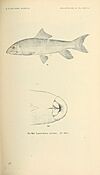 |
Carps and minnows (family Cyprinidae)
| Common name | Scientific name | Range | Comments | Pictures |
|---|---|---|---|---|
| Maravillas red shiner | Cyprinella lutrensis blairi | Maravillas Creek, Texas | Last collected in 1954. Exterminated by introduced plains killifish. | |
| Mexican dace | Evarra bustamantei | Xochimilco-Tlahuac channels in the Valley of Mexico | Last collected in 1970. Likely extinct due to habitat destruction through pollution and water extraction. | |
| Plateau chub | Evarra eigenmanni | Chalco and Xochimilco-Tlahuac channels | Last collected in 1954. Likely extinct due to habitat destruction through pollution and water extraction. | |
| Endorheic chub | Evarra tlahuacensis | Lake Chalco in the Valley of Mexico | Last collected in 1970. Extinct due to habitat destruction and water pollution. | |
| Independence Valley tui chub | Gila bicolor isolata | Warm Springs, Nevada | Last collected in 1966. Likely exterminated by introduced largemouth bass. | |
| Thicktail chub | Gila crassicauda | California Central Valley and San Francisco Bay | Last collected in 1957. Extinct due to the conversion of the Central Valley to intensive agriculture, marsh draining, channelization of rivers and introduction of extotic fish species. |  |
| Pahranagat spinedace | Lepidomeda altivelis | Pahranagat Valley, Nevada | Last collected in 1938. Extinct due to predation by, and competition with the mosquitofish and other introduced species. | |
| Durango shiner | Notropis aulidion | Tunal River, Durango, Mexico | Last collected in 1961. Possibly extinct due to pollution, competition and predation by the largemouth bass and other introduced species. |  |
| Salado shiner | Notropis saladonis | Salado River, Mexico | Not found in any sampling expeditions launched since 1988. The reasons of extinction are unknown. | |
| Rio Grande bluntnose shiner | Notropis simus simus | Upper Rio Grande and the Pecos River | Last collected in 1964. Possibly extinct due to changes in the water flow caused by dams, irrigation, and channelization, along with competition from introduced species. | |
| Phantom shiner | Notropis orca | Rio Grande | The only pure individual known is the holotype taken in 1975, though hybrids with the bluntnose shiner are known as far as 1891. Possibly extinct due to changes to the water flow (which increased hybridization), increased salinity caused by irrigation, and introduced fish species. | |
| Clear Lake splittail | Pogonichthys ciscoides | Clear Lake and its tributaries, California | Last collected in 1970. Extinct due to extreme eutrophication of the lake caused by agriculture. | |
| Banff longnose dace | Rhinichthys cataractae smithi | Banff National Park, Alberta | Extinct since 1986. Declined after the introduction of several exotic species including mosquitofishes, sailfin mollies, guppies, convict cichlids, and green swordtails, followed by the alteration of water flows related to the use of hotsprings as public baths and sewage spillage. As numbers fell the subspecies became more vulnerable to hybridization with R. c. cataractae, which caused its final extinction. | |
| Las Vegas dace | Rhinichthys deaconi | Las Vegas Valley, Nevada | Last collected in 1940. The springs it inhabited were destroyed during the urban development of Las Vegas. | |
| Grass Valley speckled dace | Rhinichthys osculus reliquus | Lander County, Nevada | Known only from the type series of 474 specimens collected in 1938. Though abundant in this time, it was completely gone and replaced by introduced rainbow trout and brook trout when a second collection attempt was made in 1969. | |
| Stumptooth minnow | Stypodon signifer | Southern Coahuila, Mexico | Last collected in 1903. It was a mollusc-eating specialist, and molluscs were greatly affected by habitat modification and pollution caused by agriculture. |
Extinct in the wild
| Common name | Scientific name | Range | Comments |
|---|---|---|---|
| Ameca shiner | Notropis amecae | Ameca River, Jalisco, Mexico | Last found in the wild in 2008. Captive individuals were reintroduced in 2016, but it is unclear if the new population is viable. The exact cause of extinction is unknown, but habitat loss due to water extraction has been suggested. |
Catfishes (order Siluriformes)
Ictalurids (family Ictaluridae)
| Common name | Scientific name | Range | Comments |
|---|---|---|---|
| Scioto madtom | Noturus trautmani | Big Darby Creek, Ohio | Last collected in 1957. The cause of extinction is unknown. |
Salmon, trout and relatives (order Salmoniformes)
Salmon, trout and relatives (family Salmonidae)
| Common name | Scientific name | Range | Comments | Pictures |
|---|---|---|---|---|
| Longjaw cisco | Coregonus alpenae | Lakes Erie, Michigan, and Huron | Last collected in Lake Erie in 1957, in Lake Michigan in 1967, and in Lake Huron in 1975. Extinct due to overfishing, predation by the sea lamprey which colonized the lakes in the 1940s, and hybridization with other ciscoes. | |
| Deepwater cisco | Coregonus johannae | Lakes Michigan and Huron | Last collected in Lake Michigan in 1951, and in Lake Huron in 1952. Extinct due to overfishing, sea lamprey predation, and hybridization with other ciscoes. |  |
| Lake Ontario kiyi | Coregonus kiyi orientalis | Lake Ontario | Last collected in 1964. Extinct due to overfishing, introduced fishes, and deterioration of water quality caused by eutrophication and chemical pollution. | |
| Blackfin cisco | Coregonus nigripinnis | Lakes Michigan and Huron | Last collected in 1923 in Lake Huron, and 1969 in Lake Michigan. Extinct due to overfishing, sea lamprey predation, and hybridization with other ciscoes. |  |
| Yellowfin cutthroat trout | Oncorhynchus clarkii macdonaldi | Twin Lakes, Colorado | Extinct around 1910 as a result of competition and hybridization with introduced fishes. | |
| Alvord cutthroat trout | Oncorhynchus clarki ssp. | Alvord Basin in Oregon and Nevada | Only known from individuals hybridized with the rainbow trout, which was introduced to the area in the early 1930s. | |
| Silver trout | Salvelinus agassizi | Dublin Pond and Christine Lake, New Hampshire | Last recorded in Christine Lake in 1926 and in Dublin Pond in 1930. Extinct due to overfishing and several exotic fish introductions. |  |
Possibly extinct
| Common name | Scientific name | Range | Comments | Pictures |
|---|---|---|---|---|
| Shortnose cisco | Coregonus reighardi | Lakes Michigan, Ontario, and Huron | Last collected in 1985. Declined due to overfishing and sea lamprey predation. |  |
Silversides (order Atheriniformes)
Neotropical silversides (family Atherinopsidae)
Possibly extinct
| Common name | Scientific name | Range | Comments |
|---|---|---|---|
| Alberca silverside | Chirostoma bartoni | La Alberca caldera, Lerma River basin, Mexico | Not recorded after the crater lake dried during a drought in 2006. |
| Least silverside | Chirostoma charari | La Mintzita spring, Michoacan, Mexico | Last recorded in 1957. Declined due to overuse of water resources, deforestation of gallery forests, pollution, hypereutophication, and hybridization with other Chirostoma species. |
Toothcarps (order Cyprinodontiformes)
Pupfishes (family Cyprinodontidae)
| Common name | Scientific name | Range | Comments | Pictures |
|---|---|---|---|---|
| Villa Lopez pupfish | Cyprinodon ceciliae | Bolsón de Sandía, Nuevo León, Mexico | Last recorded in 1988. The spring it was endemic dried completely in 1991 as a consequence of water extraction for agriculture use. | |
| Cachorrito de la Trinidad | Cyprinodon inmemoriam | Ojo La Trinidad, northern Mexico | Only known from the holotype collected in 1984. The spring it was found in was destroyed by water extraction. | |
| Tecopa pupfish | Cyprinodon nevadensis calidae | Tecopa Hot Springs, California | Last recorded before 1972. |  |
| Catarina pupfish | Megupsilon aporus | Potosí Spring, Nuevo León, Mexico | Last recorded in the wild in 1994, and in captivity in 2012. Extinct due to groundwater extraction and introduced fish species. |  |
Possibly extinct
| Common name | Scientific name | Range | Comments |
|---|---|---|---|
| Parras pupfish | Cyprinodon latifasciatus | Parras drainage basin, Coahuila, Mexico | Last collected in 2012. Declined due to pollution, introduced guppies and green swordtails. |
Extinct in the wild
| Common name | Scientific name | Range | Comments |
|---|---|---|---|
| Potosi pupfish | Cyprinodon alvarezi | Potosí Spring, Galeana, Nuevo León, Mexico | Last recorded in the wild in 1994. Declined due to near total habitat loss as a result of groundwater extraction, predation and competition with introduced species. |
| La Palma pupfish | Cyprinodon longidorsalis | Bolsón de Sandía, Nuevo León, Mexico | Last recorded in the wild in 1994, as a result of groundwater extraction. |
| Charco Palma pupfish | Cyprinodon veronicae | Disappeared from the wild in 1995 as a result of groundwater extraction, which caused in 1997 the complete drying of the spring it was endemic to. |
Topminnows and North American killifishes (family Fundulidae)
| Common name | Scientific name | Range | Comments | Pictures |
|---|---|---|---|---|
| Whiteline topminnow | Fundulus albolineatus | Spring Creek, Huntsville, Alabama | Last collected in 1889. Probably extinct due to habitat degradation through channelization and construction, water extraction for urban use, or introduced common carp and goldfish. |  |
Splitfins (family Goodeidae)
| Common name | Scientific name | Range | Comments | Pictures |
|---|---|---|---|---|
| Parras characodon | Characodon garmani | Southern Coahuila, Mexico | Known only from the holotype collected around the 1880s. Likely extinct due to habitat alteration. | |
| Raycraft Ranch killifish | Empetrichthys latos concavus | Pahrump Valley, Nevada | Last collected in 1953. Likely extinct due to introduced carp and bullfrogs; after its probable extinction, the spring it was endemic to was filled to eliminate mosquitos. | |
| Pahrump Ranch poolfish | Empetrichthys latos pahrump | Nye County, Nevada | Last recorded in 1958. Likely extinct due to excessive water extraction, introduced carp and bullfrogs. | |
| Ash Meadows killifish | Empetrichthys merriami | Ash Meadows, Nevada | Last collected in 1948. Likely extinct due to habitat alteration and predation by introduced bullfrogs and crayfish. |  |
Extinct in the wild
| Common name | Scientific name | Range | Comments | Pictures |
|---|---|---|---|---|
| Banded allotoca | Allotoca goslinei | Jalisco, Mexico | Last recorded in the wild in 2004. Declined rapidly from 2000 after green swordtails were introduced in its last known location. |  |
| Golden skiffia | Skiffia francesae | Teuchitlan River and Laguna de Sayula, Jalisco, Mexico | Declined due to habitat degradation and exotic fish introductions. The last known wild population disappeared when the El Molino pond dried during a drought in 2010. |
Poeciliids (family Poeciliidae)
| Common name | Scientific name | Range | Comments |
|---|---|---|---|
| Amistad gambusia | Gambusia amistadensis | Goodenough Spring, Texas | 1968 |
| San Marcos gambusia | Gambusia georgei | San Marcos River and spring, Texas | Last recorded in 1983. Extinct due to reduced spring flows, pollution, introduced fishes and ornamental plants, and hybridization with mosquitofish. |
Possibly extinct
| Common name | Scientific name | Range | Comments |
|---|---|---|---|
| Graceful priapella | Priapella bonita | Motzorongo River, Veracruz, Mexico | Last recorded in 1965. The cause of extinction is unknown. |
Extinct in the wild
| Common name | Scientific name | Range | Comments | Pictures |
|---|---|---|---|---|
| Monterrey platyfish | Xiphophorus couchianus | Atlantic slope of Mexico | Last collected in the wild in 1967. Declined due to habitat destruction, pollution, predation and competition with introduced species. |  |
| Marbled swordtail | Xiphophorus meyeri | Melchor Muzquiz, Coahuila, Mexico | Last recorded in the wild in 1997. Declined due to water abstraction for mining activities. |  |
Lionfishes and sculpins (order Scorpaeniformes)
Cottids (family Cottidae)
| Common name | Scientific name | Range | Comments |
|---|---|---|---|
| Utah Lake sculpin | Cottus echinatus | Utah Lake | 1928 |
Sticklebacks (family Gasterosteidae)
| Common name | Scientific name | Range | Comments |
|---|---|---|---|
| Hadley Lake sticklebacks | Gasterosteus spp. | Hadley Lake, British Columbia | Two undescribed species extinct in 1999. Other species of the same genus survive in the lake. |
Perchs and allies (order Perciformes)
Perchs (family Percidae)
| Common name | Scientific name | Range | Comments | Pictures |
|---|---|---|---|---|
| Maryland darter | Etheostoma sellare | Lower Susquehanna River, United States | Last confirmed record in 1986 and a possible one in 1988. Its range contracted after the damming of the Susquehanna; the last known location has degraded water quality caused by agriculture. | |
| Blue walleye | Sander vitreus glaucus | Lakes Ontario and Erie, and Niagara River | Population began to fluctuate wildly in 1915 as a result of over-fishing before it collapsed in 1958. The final individuals may have hybridized with walleye. |  |
Malacostracans (class Malacostraca)
| Common name/scientific name | Extinction date | Range | Image |
|---|---|---|---|
| Cambarellus alvarezi | 1991 | Potosí Spring, Nuevo León, Mexico | |
| Sooty crayfish Pacifastacus nigrescens |
19th century | San Francisco Bay, California, United States |  |
| Sandhills crayfish Procambarus angustatus |
1958 | Sand Hills, Georgia, United States | |
| Pasadena freshwater shrimp Syncaris pasadenae |
1933 | Los Angeles River drainage basin, California, United States |
| Common name/scientific name | Extinction date | Range |
|---|---|---|
| Hemigrapsus estellinensis | 1962 | Estelline Hot Spring, Texas, United States |
| White Spring cave crayfish Cambarus veitchorum |
1968 | White Spring Cave, Limestone County, Alabama, United States |
| Bigcheek cave crayfish Procambarus delicatus |
1976 | single spring in Ocala National Forest, Lake County, Florida, United States |
| Common name/scientific name | Extinction date | Range | Image |
|---|---|---|---|
| Socorro isopod Thermosphaeroma thermophilum |
1988 | Sedillo Spring, Socorro County, New Mexico |  |
Insects (class Insecta)
| Common name/scientific name | Extinction date | Range | Image |
|---|---|---|---|
| Pecatonica River mayfly Acanthometropus pecatonica |
1927 | United States | |
| Chestnut ermine moth Argyresthia castaneella |
1923 | United States | |
| California condor louse Colpocephalum californici |
c. 1985 | North America | |
| Central Valley grasshopper Conozoa hyalina |
1953 | Central Valley, California, United States | |
| Phleophagan chestnut moth Ectoedemia phleophaga |
1900s | United States | |
| Xerces blue butterfly Glaucopsyche xerces |
before 1941 | San Francisco, California, United States | 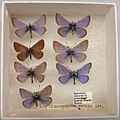 |
| Rocky Mountain locust Melanoplus spretus |
1902 | Northern Rocky Mountains |  |
| Antioch Dunes shieldback katydid Neduba extincta |
1937 | United States | |
| Oeobia sp. nov. | 1911 | United States | |
| Robust burrowing mayfly Pentagenia robusta |
1926 | Ohio River area, United States | |
| Three-toothed caddisfly Triaenodes tridontus |
1991 | United States | |
| Fort Ross weevil Trigonoscuta rossi |
1975 | Fort Ross, California, United States | |
| Yorba Linda weevil Trigonoscuta yorbalindae |
1975 | Yorba Linda desert dunes, California, United States |
Arachnids (class Arachnida)
Order Mesostigmata
Family Halarachnidae
| Common name | Scientific name | Range | Comments | Pictures |
|---|---|---|---|---|
| Caribbean monk seal nasal mite | Halarachne americana | Caribbean Sea | Extinct with its host. | 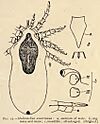 |
Molluscs
Undated
| Common name/scientific name | Range | Image |
|---|---|---|
| Carolina elktoe Alasmidonta robusta |
North and South Carolina, United States | |
| Shoal sprite Amphigyra alabamensis |
Alabama, United States | |
| Boulder snail Athearnia crassa |
Alabama, Georgia, Tennessee, and Virginia, United States | |
| Umbilicate pebblesnail Clappia umbilicata |
Alabama, United States |  |
| Short-spired elimia Elimia brevis |
Alabama, United States | |
| Closed elimia Elimia clausa |
St. Clair County, Alabama, United States | |
| Fusiform elimia Elimia fusiformis |
Coosa River, Alabama, United States | |
| Shouldered elimia Elimia gibbera |
Alabama, United States | |
| High-spired elimia Elimia hartmaniana |
United States | |
| Constricted elimia Elimia impressa |
Alabama, United States | |
| Hearty elimia Elimia jonesi |
Coosa River, Alabama, United States | |
| Ribbed elimia Elimia laeta |
Alabama, United States | |
| Wrinkled elimia Elimia macglameriana |
Alabama and Georgia, United States | |
| Pupa elimia Elimia pupaeformis |
Alabama, United States | |
| Pygmy elimia Elimia pygmaea |
Alabama, United States | |
| Rough-lined elimia Elimia pilsbryi |
Coosa River, Alabama, United States | |
| Cobble elimia Elimia vanuxemiana |
Alabama, United States |  |
| Round slitshell Gyrotoma walkeri |
Alabama, United States | |
| Agate rocksnail Leptoxis clipeata |
Alabama, United States | |
| Maiden rocksnail Leptoxis formosa |
Alabama and Georgia, United States | |
| Rotund rocksnail Leptoxis ligata |
Alabama, United States | |
| Lyrate rocksnail Leptoxis lirata |
Alabama, United States | |
| Bigmouth rocksnail Leptoxis occultata |
Alabama, United States | |
| Coosa rocksnail Leptoxis showalterii |
United States | |
| Squat rocksnail Leptoxis torrefacta |
United States | |
| Striped rocksnail Leptoxis vittata |
United States | |
| Carinate flat-top snail Neoplanorbis carinatus |
United States | |
| Angled flat-top snail Neoplanorbis smithi |
United States | |
| Umbilicate flat-top snail Neoplanorbis umbilicatus |
United States | |
| Fish Lake physa Physella microstriata |
Utah, United States | |
| Acorn ramshell Planorbella multivolvis |
Michigan, United States | |
| Highnut Pleurobema fibuloides |
United States | |
| Longnut Pleurobema nucleopsis |
United States | |
| Alabama clubshell Pleurobema troschelianum |
Alabama, Tennessee, and Georgia, United States | |
| True pigtoe Pleurobema verum |
Alabama, United States | |
| Corded purg Pyrgulopsis nevadensis |
Nevada, United States |  |
| Oachita pebblesnail Somatogyrus amnicoloides |
Arkansas, United States | |
| Tennessee pebblesnail Somatogyrus currierianus |
Alabama, United States | |
| Channeled pebblesnail Somatogyrus wheeleri |
Arkansas, United States |
Recent
| Common name/scientific name | Extinction date | Range | Image |
|---|---|---|---|
| Coosa elktoe Alasmidonta mccordi |
1964 | Coosa River, Alabama, United States | |
| Ochlockonee arcmussel Alasmidonta wrightiana |
1930s | Ochlockonee River, Florida, United States | |
| Cahaba pebblesnail Clappia cahabensis |
1965 | Cahaba River, Alabama, United States | 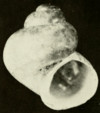 |
| Arc-form pearly mussel Epioblasma arcaeformis |
1940s | Cumberland and Tennessee River systems, United States |  |
| Angled riffleshell Epioblasma biemarginata |
1970 | Cumberland and Tennessee River systems, United States |  |
| Arcuate pearly mussel Epioblasma flexuosa |
1920s-1930s | Tennessee, Cumberland, and Ohio River systems, United States |  |
| Curtis pearly mussel Epioblasma florentina curtisi |
1990s | Little Black River, Missouri, United States | |
| Yellow blossom Epioblasma florentina florentina |
1940s | Holston River, Tennessee, United States | |
| Acorn pearly mussel Epioblasma haysiana |
1970 | Cumberland and Tennessee River systems, United States |  |
| Stone's pearly mussel Epioblasma lenior |
1967 | Tennessee River system, United States | |
| Lewis pearly mussel Epioblasma lewisii |
1950 | Cumberland and Tennessee River systems, United States | |
| Upland combshell Epioblasma metastriata |
1980s | Conasauga River, Georgia, United States | |
| Southern acornshell Epioblasma othcaloogensis |
1970s | Conasauga River, Georgia, United States | |
| Fine-rayed pearly mussel Epioblasma personata |
1924 | Tennessee, Ohio, and Wabash River systems, United States | |
| Nearby pearly mussel Epioblasma propinqua |
1936 | Tennessee, Cumberland, Ohio, and Wabash River systems, United States |  |
| Sampson's pearly mussel Epioblasma sampsonii |
1930s-1940s | Kentucky, Illinois, and Indiana, United States |  |
| Steward's pearly mussel Epioblasma stewardsonii |
1940s | Tennessee and Coosa River systems, United States |  |
| Green-blossom pearly mussel Epioblasma torulosa gubernaculum |
1984 | Tennessee River system, United States |  |
| Tubercled-blossom pearly mussel Epioblasma torulosa torulosa |
1970s | Tennessee and Ohio River systems, United States | |
| Turgid-blossom pearly mussel Epioblasma turgidula |
1976 | Southern Appalachians and Cumberland Plateau, United States |  |
| Excised slitshell Gyrotoma excisa |
1924 | Alabama, United States | |
| Striate slitshell Gyrotoma lewisii |
1924 | Alabama, United States | |
| Pagoda slitshell Gyrotoma pagoda |
1924 | Alabama, United States | |
| Ribbed slitshell Gyrotoma pumila |
1924 | Alabama, United States | |
| Pyramid slitshell Gyrotoma pyramidata |
1924 | Alabama, United States | |
| Lined pocketbook Lampsilis binominata |
1970s | Flint River, Georgia, United States |  |
| Eelgrass limpet Lottia alveus |
1929 | Atlantic Canada and the United States | |
| Olive marstonia Marstonia olivacea |
1940 | Big Sprink Creek, Madison County, Alabama, United States | |
| Little flat-top snail Neoplanorbis tantillus |
c. 1914-1967 | Coosa River, Alabama, United States |  |
| Black clubshell Pleurobema curtum |
1990s | East Fork Tombigbee River, Mississippi, United States | |
| Flat pigtoe Pleurobema marshalli |
1984 | Tombigbee River, Mississippi and Alabama, United States | |
| Rio Grande monkeyface Quadrula couchiana |
early 1900s | Rio Grande | |
| Stirrup shell Quadrula stapes |
1980s | Sipsey River, Alabama, United States | |
| Thick-lipped pebblesnail Somatogyrus crassilabris |
1915 | White River, Baxter County, Arkansas, United States |
See also
- Holocene extinction
- Timeline of extinctions in the Holocene
- Settlement of the Americas
- List of South American animals extinct in the Holocene
- List of extinct animals
- List of extinct animals of the Hawaiian Islands
- List of extinct birds
- Extinct in the wild
- Lazarus taxon
- U.S. Fish and Wildlife Service
- IUCN Red List of Threatened Species
- Environmental history of the United States

All content from Kiddle encyclopedia articles (including the article images and facts) can be freely used under Attribution-ShareAlike license, unless stated otherwise. Cite this article:
List of North American animals extinct in the Holocene Facts for Kids. Kiddle Encyclopedia.

